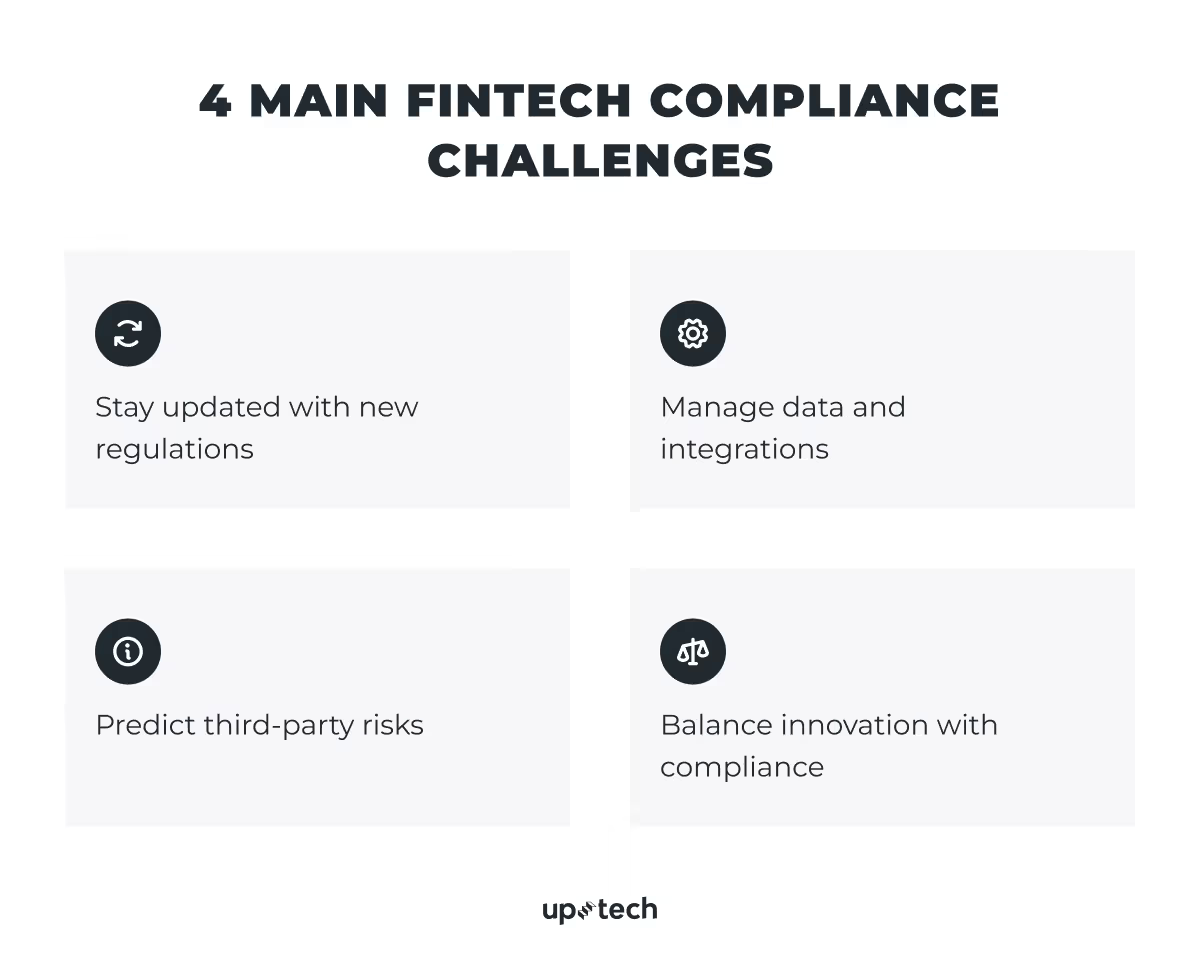It might surprise the naysayers, but fintech has gone from a niche market to a mainstream finance industry. The numbers, if anything, don't lie. From 3.56 billion users in 2023, the digital payment industry is still growing and is predicted to have 4.81 billion users by 2028. If anything, CTOs and founders must pay more attention to fintech compliance than ever.
Whether you’re building a neobank, investment app, or other fintech products, compliance is mandatory. And the price of non-compliance is astronomical, as some fintechs found out. For example, the Starling Bank was fined $38.5 million in 2025 because of inadequate safeguards for preventing financial crime.
A gentle reminder from us: don’t ignore regulatory compliance. And be aware of the legal, reputational, and financial costs at stake. Data breaches, monetary losses, and lawsuits are complications that you might face if you fail to take compliance seriously.
The thing is — it’s not easy to comply with fintech regulations. But can avoid the costly penalties with the right compliance strategy.
I’m Anastasiia Kazakova, the Product Manager at Uptech. Over the years, I’ve worked with fintech clients like Aspiration and Cardless, and I understand the complexities involved when complying with fintech laws.
In this guide, I’ll walk you through:
- key regulations fintech companies must comply with;
- possible challenges in doing so;
- ways to integrate compliance with your products.
Let’s start.
What is Fintech Compliance?
It’s about following the laws that apply to fintech companies. Initially, fintech startups operate in a grey area, because the services they offer are new to the financial industry. For example, when crypto exchange first hit the market, regulators still tried to understand how it would affect the industry. Then, laws were made to protect investors from falling into scams or unethical practices.
Today, nearly every country has some form of fintech compliance standards that fintech companies must comply with. For example, suppose you decide to create an investment app in the US. To do this, the first step will be to pass the strict requirements imposed by the regulatory bodies.
We'll go into this later, but what we wanted to say is that you can no longer launch a fintech app as easily as before. You’ll need to ensure they are designed according to compliance laws. Otherwise, you might face penalties, just like what this Ohio man faced, a whopping $300 million fine for violating AML laws with his crypto service.

8 Main Fintech Compliance Regulatory Bodies: USA, Europe, and International Markets
A question that we often receive when working with fintech companies is, ‘What are the main regulations for fintech?’ Well, the answer is, it depends.
To date, efforts are still ongoing to unify fintech regulatory standards globally. There aren’t many international bodies that govern fintechs. Instead, fintech companies fall under the jurisdiction of agencies in the countries or regions in which they operate.
Main fintech compliance regulations in the United States
If your company is based in the United States or plans to expand your user base there, you’ll need to abide by laws these agencies enact.

Consumer Financial Protection Bureau (CFPB)
The CFPB wants to ensure that fintech companies are treating consumers fairly by being honest about their charges and policies. It also gives consumers the right to settle disagreements they encounter with banks and fintechs. Failure to comply with this can incur severe penalties. Wells Fargo in 2022 was ordered to pay a $3.7 billion penalty for overcharging customers interest rates among other violations.
Office of the Comptroller of the Currency (OCC)
The OCC establishes guidelines and laws so that banks within the US operate in a safe, competitive, and fair environment. It enforces laws requiring banks and financial institutions to engage in anti-money laundering, consumer protection, lending, and other laws. If your company works with a national bank or offers products that are subject to banking regulations, you must follow laws OCC regulates.
Financial Crimes Enforcement Network (FinCEN)
FinCEN assists the US government in combating financial crimes such as money laundering and terrorist financing. It regulates the Bank Secrecy Acts (BSA), which financial institutions, even including fintech companies must abide by. TD Bank, one of the largest banks in the country, was fined $1.3 billion for non-compliance with the BSA.
Federal Trade Commission (FTC)
The FTC advocates for fair and anti-competitive business practices in the US. Additionally, it ensures that fintech comply with the Gramm-Leach-Bliley Act (GLBA), which protects the customer’s financial data. As long as your product accepts payment, manages finance data, or lends to consumers, you must comply with the act.
Federal Financial Institutions Examination Council (FFIEC)
It's hard to become compliant as there are so many different authorities creating and executing their own acts. And that’s where the FFIEC comes into play. The council harmonizes compliance enforcement across the agencies and standardizes how financial institutions are examined.
Main fintech compliance regulations in Europe
Fintech companies that operate in Europe must adhere to region-based authorities. Below are the major ones.

European Banking Authority (EBA)
The EBA makes sure that regulators of national banks act the same when they enforce their respective rules. On top of that, the EBA also has a key role in tackling financial crime and issuing guidance around AI in finance.
General Data Protection Regulation (GDPR)
GDPR is the other law that all fintech firms serving the EU region need to satisfy. In order to do so, they must ensure that their product adheres to data privacy policies that are mandated by the law. As an example, consumers have a right to know what data is being collected, how their data are stored, and why they’re collecting them. They can also refuse to allow the fintech apps to collect their data, or request their data to be deleted.
International main fintech compliance regulations
In addition to having to abide by regional and country-based financial regulations, fintech startups do find themselves affected by more globally applicable guidance.

Financial Action Task Force (FATF)
The global organization creates guidelines for financial institutions in its jurisdiction worldwide to prevent financial crimes. While the FATF doesn’t directly enforce laws, it is highly influential in shaping anti-money laundering and counter-terrorist financing acts, like the Bank Secrecy Act.

Key Areas of Fintech Compliance
Financial apps are designed with flexibility in mind, but oversight in fintech security can subject them to abuse. Just recently, LoanDepot, a mortgage lender, fell victim to a data breach that compromised the privacy of 16.6 million users. Again, this underscores the need for strict compliance in fintech. Without proper standards, fintech companies will continue operating in grey areas, which will subject them to cyber threats.
So, it’s important to understand what regulatory bodies aim to achieve when they enact and enforce laws that govern fintech companies. As the CTO or founder, you need to pay attention to these compliance goals when starting a fintech app design. Otherwise, your company will grapple with trust issues, along with data security and reputational concerns.

Prevent financial crimes
One of the main purposes of fintech laws is to stop cybercriminals if they plan to steal money from users or fund terrorist activities.
Fintech regulators require companies to implement robust Know Your Customer (KYC) workflows in their products. This way, fintech companies can vet all users before they can fund their accounts.
For example, neobank allows users to create an account from their mobile phone. Without a physical presence, you need a series of KYC steps, such as taking selfie videos and snapshots of the identity cards, to validate new users. Otherwise, you wouldn’t meet KYC requirements set forth by regulatory bodies.
Learn more about our neobank app development services here.
Protect data and privacy
Cybercriminals find fintech companies an attractive target because of the immense volumes of data and transactions involved. Thankfully, fintech compliance regulations like GDPR and CCPA exist to ensure data security and protect consumer privacy. Under such acts, fintech companies are legally required to apply cybersecurity measures, such as encryption and multi-factor authentication, to secure their data pipeline.
At Uptech, we balance user experience and security in the fintech apps we build. Rather than leaving security in the end, we prioritize it throughout the development workflow. You can learn more about how to build a fintech app that users trust in our blog.
Ensure fair practices for consumers
Consumers not only want an app that keeps their money safe, but they also want to be treated fairly when performing transactions. If you build a secure payment system, you’ll also need to ensure there are no hidden charges or policies that might discriminate against certain consumer groups. Because most fintech products operate differently from conventional banking systems, agencies like CFPB exist to ensure fintech entities render their services fairly.
What Are The Main Fintech Compliance Challenges? + Solutions
By now, I hope I‘ve done enough to stress the importance of regulatory compliance in fintech. As a result, we often hear about fintech companies of all sizes receiving heavy fines simply because they failed to meet all regulatory requirements while developing their products. Some unluckiest few even fell prey to cyberattacks and incurred even greater losses.
To be honest, it’s hard to keep up with every law. For some companies, they must adhere to more rules than others, depending on the product and the legal jurisdiction. So, I can totally relate to what you feel going through all the legal documentation.
Yet, you’re not alone in the struggles to comply with fintech laws. Many companies face the same challenges, especially the ones below.

Stay updated with new regulations
As fintech evolves, authorities must amend regulations to protect consumers' interests. However, some companies, especially startups, might struggle to keep up because they lack resources. As a result, they might violate the acts and get penalized.
Solution: Fintech companies must continuously monitor for legal changes and adapt their product accordingly. In this case, it helps to study AI and ML trends in fintech and leverage advanced technologies. For example, you can use AI to automatically detect money laundering activities instead of relying on manual efforts. Then, you assign a project manager or engineer to review the updates. At Uptech, we always update our clients on changes to compliance requirements that they need to pay attention to.
Data management and integration
One thing you need to bear in mind when you develop a fintech product is the massive amount of data involved. This poses a considerable challenge when you want to secure the data for the sake of compliance. On the one hand, you must ensure data consistency, and on the other, you need to prevent disruption when you apply compliance measures throughout the system.
At Uptech, we help clients choose the appropriate data storage. Then, we set the appropriate compliance, security, and governance policies to protect the data that apps collect and use.
Solution: To balance data consistency and security, you need a robust data governance framework. For example, your developers create an automated and encrypted data pipeline to ensure all updates take effect consistently across the entire architecture.
Third-party risk management
The fact is — you don’t have complete control over compliance and security risks. Most fintech startups rely on third-party services, such as payment gateways, account management, or reporting. They are subjected to security flaws inherited from these external vendors. Basically, there’s no way to go around it if you want to be in compliance. Like it or not, you have to choose trusted and compliant services.
Solution: Do your due diligence before contracting any third-party vendors. Go through their product specs, policies, and service level agreements to ensure they align with fintech regulations. After engaging them, periodically assess their services to ensure they remain compliant.
Balance innovation with compliance
Scaling is one of the fintech challenges because it’s so easy to overlook compliance at the expense of speed and innovation. For example, fintech companies might get carried away with the latest generative AI technologies. However, without proper knowledge about the data privacy challenges involved, they may violate acts like GDPR when introducing AI features into their product.
Solution: Don’t make assumptions about the laws. Rather, we suggest that you consult legal and technological experts when planning app design. You’ll find that their viewpoints are helpful when you make decisions. Also, as you innovate with compliance, you don’t have to worry about costly rework due to non-compliance later on.
How to Ensure Compliance in Fintech: 6 Steps
Although challenging, it’s possible to comply with regulations governing the fintech industry. The keys to doing so are to understand the acts involved, assess technological risks, and plan for compliance right from the start.
Some fintechs might want to reduce compliance expenses by skipping certain security requirements. But the truth is — while striving for compliance will increase the fintech app development cost, the effort ensures your company stays on the right side of the law at all times.
At Uptech, we’ve helped fintech companies balance compliance with product development. Here’s how you can do it, too.

Step 1. Appoint a Chief Compliant Officer
You’ll need an expert team or an individual well-versed in the fintech laws your company needs to comply with. In some fintech companies, the responsibility falls on the Chief Compliance Officer, who is often supported by a team of legal professionals.
Be it in a startup or a growing company; the compliance team plays a pivotal role in keeping track of new or changing fintech requirements. Also, they work closely with the product team to ensure the app design reflects all the legal requirements.
Step 2. Prepare compliance documents, policies, and procedures
Next, you’ll need to prepare the documents that regulators need for subsequent audits. This includes your business plans, financial projections, bank statements, and other relevant documents.
While preparing the documents, your compliance team also creates policies and procedures related to the specific fintech laws. For example, most fintech companies need to comply with PCI DSS regulations, KYC/AML, BSA, and anti-fraud requirements. Thus, they need policies and procedures to support such implementations in their products.
Step 3. Manage third-party risks
Chances are, you will be using third-party software or services in your fintech app. As we previously mentioned, there are risks in doing so. Therefore, put together protocols for assessing potential vendors before and after contracting them.
Remember to document the risk assessment you’ve carried out on each vendor, as regulators might need them as proof for due diligence. Also, periodically re-assess your collaboration with the vendors to identify and remedy compliance gaps.
Step 4. Automate compliance monitoring
I know that manually managing a company-wide compliance effort can be overwhelming. With the amount of data spread over various exchange points, fintech companies might overlook critical checkpoints and risk penalties. In fact, this is a concern that many of our clients raise to us.
In this case, you can consider investing in compliance management software, particularly AI-powered ones. Such software can automatically monitor your product and its dependencies for compliance breaches. More importantly, the software can also report violations to the compliance team.
Step 5. Conduct regular audits and assessments
Despite your best efforts, you might still unknowingly violate certain fintech laws. For example, fast-changing requirements might catch your product team by surprise, leaving them in a race against time to modify the product. However, based on our experience, there are ways to mitigate compliance changes.
Over the years, we have helped fintech clients stay compliant despite frequently changing regulations. We do not provide audit services but to avoid nasty legal surprises, we assist our clients in finding a third-party audit firm to conduct regular audits..
Step 6. Train your employees
I know that getting all the legal work in order can be overwhelming. However, it helps to remember that fintech compliance is a shared responsibility. And it doesn’t fall on the compliance or the product team alone. So, make sure all your team members are on the same page regarding how compliance applies to their job functions.
Usually, the audit or a third-party agency is responsible for conducting such compliance training tailored to the respective business units. So you don’t need to do it yourself.
How to Outsource Software Development with Compliance in Mind
I understand if some companies hesitate to outsource software development to external vendors. While outsourcing allows them to reduce cost, they’re concerned that the vendor they engage might not be able to comply with the required standards. And this will double the risks that fintech companies face.
Despite such concerns, there are outsourcing vendors who take compliance seriously. More importantly, they have a solid track record to prove so. As for Uptech, we’ve built, and are still building, apps for fintech startups and companies in strictly regulated markets.
So, it’s very important to get the right software development partner if you choose to outsource. Below, I show you the steps that lead to our clients finding us.
Select the right development partner
Not all software development vendors are technically equipped to produce compliant fintech apps. Some might be inexperienced or lack the skillsets to secure data in ways required by regulatory bodies. Others might be overwhelmed by the rapid pace as compliance requirements grow.

So, hire fintech developers with a prior history of creating compliant software. For example, fintech companies like Aspiration and Cardless chose us to build fintech apps for the US market. To build those apps, we work closely with the clients to make sure they comply with data privacy, AML/KYC, and other regulations in the United States.
Partner with compliant 3rd party services only
From our experience, some fintech companies don’t question whether the 3rd party services they use are compliant until it's too late. When you’ve already integrated them into your app, you will most likely fail the compliance checks. The workaround is often costly because you need to rebuild or make large modifications to the app as you replace the services.
Therefore, we always vet the external services we use for compliance, especially critical ones like payment gateway, credit scoring, or user authentication. To be safe, we maintain a list of compliant services we trust, such as Stripe, Plaid, Galileo, SendBird, and Zendesk.
Integrate compliance into the development process
I need to stress this again — compliance requires teamwork. Anything less than that can result in delays, reworks, or, in some cases, penalties. So, you’ll need to get all the parties involved when you want to build an app. And that includes developers, compliance, and other stakeholders. Before we start any fintech project, we’ll discuss with compliance experts and developers to identify:
- The fintech laws we need to adhere to.
- Technologies needed to meet those requirements, including encryption, KYC onboarding, and other data security measures.
- Compliance policies and procedures to guide the development.
While our internal team works through the technicalities, we also communicate the progress to our clients. For example, when building this green investment app for the UK market, we kept our client updated throughout the development stages. As a result, we managed to produce a GDPR-compliant app that users find attractive.
Post-development compliance assurance
Remember, achieving compliance in fintech isn’t a one-time effort. When you compare various fintech software development services, also consider post-deployment support. After you’ve launched your product, you’ll still need to make an ongoing effort to address new laws, changing requirements, or existing compliance gaps.
We hope you find this guide helpful, particularly in developing products that comply with fintech laws. If you’re still doubtful, talk to our team.
FAQs
1. Are fintech companies regulated?
Yes. Fintech companies are regulated in most countries. If you want to start a fintech company, you must comply with AML/KYC, data privacy, and other cybersecurity or finance acts. Some fintech products are also subjected to banking laws, which fall under the jurisdiction of authoritative bodies like the SEC and OCC.
2. What is a fintech compliance checklist?
It’s a guide that helps you satisfy fintech requirements. Depending on the product you build, the checklist may vary slightly. However, it’ll most likely consist of:
- Business model and licenses.
- AML/KYC procedures.
- Data security and privacy policies.
- Customer protection procedures.
- Risk management plan.
- Compliance monitoring and reporting guidelines.
3. How can fintech startups stay updated with changing regulations?
You need to adopt a compliance-first mindset when developing your product. And this means balancing compliance with software engineering. This way, you can monitor for compliance gaps and deploy prompt updates should the regulations change. For example, if you start with an encrypted database, you’ll have less trouble upgrading data storage security features than with an unencrypted database.
4. What are the penalties for non-compliance in fintech?
Non-compliance can result in hefty fines by regulatory bodies. For example, Binance was fined $4.3 billion for violating anti-money laundering laws in 2023. But that’s not the only negative outcome. If your company violates fintech laws, you might also lose trust amongst users, suffer from data breaches, or lose the license to operate in the region.
5. How does outsourcing software development affect compliance?
When you outsource, you’re putting your trust in the software development vendor. If they don’t have experience building and supporting fintech-compliant apps, your product might risk violating fintech acts. Some app developers might also lack the expertise and technology to implement robust data security, which might compromise data security and user privacy. To be safe, work with an experienced, compliant fintech app developer like Uptech.












































































.avif)























